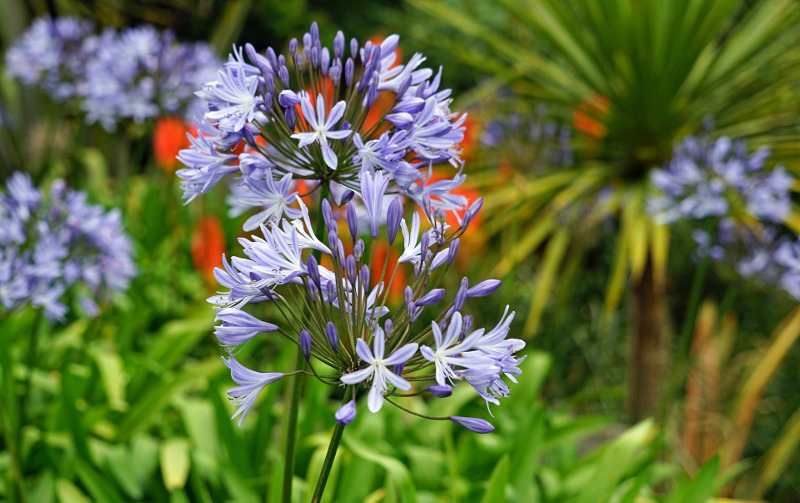Agapanthus Growing Problems: Soil, Sunlight, and Watering
Agapanthus Growing Problems: Soil, Sunlight, and Watering
Blog Article
Unleashing the Secret to Successful Agapanthus Farming: Tips and Techniques for a Flourishing Garden
In the realm of horticulture, growing agapanthus effectively needs a strategic technique that incorporates different elements of plant care. By understanding the nuances of agapanthus growing, one can create a setting where these plants flourish and flower generously.
Growing Agapanthus: Finest Practices
When planting Agapanthus, proper soil prep work is crucial for ensuring effective growth and advancement of these stunning flowers. Agapanthus, frequently known as Lily of the Nile or African lily, prospers in well-draining soil with a somewhat acidic to neutral pH level - Agapanthus. Before planting, it is vital to change heavy clay dirts with raw material such as compost or peat moss to boost drainage and provide vital nutrients for the plants
To grow Agapanthus, select a place that gets complete sunlight to partial color, as this will certainly promote healthy growth and plentiful flowering. Dig a hole two times the size of the plant's root ball and place the Agapanthus at the same depth it was previously growing. Gently backfill the hole with soil, pushing down securely to remove any air pockets around the roots.
Water the freshly grown Agapanthus completely and continue to maintain the soil equally moist, particularly throughout the plant's energetic growing season. Agapanthus. Applying a well balanced plant food once a month can further support the plant's growth and blooming. By complying with these best methods for growing Agapanthus, you can produce a sensational display screen of these captivating blossoms in your garden
Suitable Soil Conditions for Agapanthus
For optimal growth and blooming success of Agapanthus plants, making sure the soil problems are excellent is crucial. Agapanthus favors soil that is rich in nutrients, so incorporating a balanced plant food during the growing period can advertise healthy and balanced growth and lively blossoms.

Watering and Feeding Tips
To guarantee healthy and balanced growth and vibrant blossoms, appropriate watering and fertilizing strategies are crucial for successful Agapanthus farming. Agapanthus plants take advantage of normal watering, specifically throughout the growing period. It is recommended to water deeply as soon as a week, making certain the dirt is moist however not waterlogged. During warm weather or in pots, even more constant watering might be essential to avoid the soil from drying totally.
When it involves fertilizing Agapanthus, a balanced plant food with equal parts nitrogen, phosphorus, and potassium can be applied in the springtime to promote healthy development and blooming. Slow-release plant foods are perfect for giving nutrients slowly over an extensive period. Prevent over-fertilizing, as this can bring about excessive foliage growth at the cost of flowers.
Furthermore, including raw material like compost right into the dirt Discover More can enhance nutrient degrees and improve soil framework, helping in the general wellness of the Agapanthus plants. By complying with these watering and feeding suggestions, gardeners can guarantee their Agapanthus plants prosper and generate sensational displays of flowers.
Trimming and Deadheading Strategies
Correct pruning and deadheading techniques play an important duty in maintaining the wellness and aesthetics of Agapanthus plants, matching the vital techniques of watering and feeding for effective growing. Pruning Agapanthus includes eliminating invested flower heads, dead or yellowing fallen leaves, and general shaping of the plant to advertise far better growth. Deadheading, the procedure of removing faded flowers, not only improves the plant's appearance but likewise urges additional growing.
When deadheading Agapanthus, it is suggested to clip off the blossom stem at the base making use of sharp, tidy shears. This procedure redirects the plant's power from seed production back into origin and vegetation growth, advertising a much healthier and more robust plant. Routine deadheading can expand the growing period of Agapanthus and protect against self-seeding, which can cause overcrowding.
In regards to pruning, Agapanthus usually benefits from a light trim after blooming to tidy up the plant and encourage fresh development. Cutting down the invested flower stems and removing any damaged or dead foliage helps keep the plant's vitality and total appearance. However, it is vital to stay clear of reducing into the crown of the plant, as this can damage its wellness.

Protecting Agapanthus From Vermins and Diseases
Executing effective pest and illness monitoring approaches is crucial to securing the health and vigor of Agapanthus plants in farming. One typical pest that impacts Agapanthus is the Agapanthus borer, a caterpillar that tunnels right into the plant, my site creating damage to the fallen leaves and flowers.
In addition to bugs, Agapanthus are susceptible to diseases such as origin rot and fungal fallen leave places. By remaining attentive and addressing parasite and illness issues without delay, garden enthusiasts can aid their Agapanthus grow and flourish.

Verdict
In conclusion, successful farming of agapanthus calls for proper planting techniques, perfect dirt problems, ample watering and fertilizing, regular pruning and deadheading, and protection from conditions and bugs. By following these techniques and suggestions, gardeners can make sure a flourishing garden loaded with beautiful agapanthus flowers. Agapanthus. Remember to maintain consistent care and interest to detail to promote the health and long life of these sensational plants
When planting index Agapanthus, correct dirt prep work is necessary for making sure successful development and advancement of these lovely flowers.Water the recently grown Agapanthus extensively and proceed to keep the dirt evenly wet, particularly during the plant's energetic growing season.For optimal growth and flowering success of Agapanthus plants, guaranteeing the soil conditions are suitable is critical. When growing or hair transplanting Agapanthus, make certain the dirt is well-prepared to supply the essential foundation for the plants to establish themselves efficiently. One typical insect that influences Agapanthus is the Agapanthus borer, a caterpillar that passages into the plant, triggering damage to the fallen leaves and flowers.
Report this page